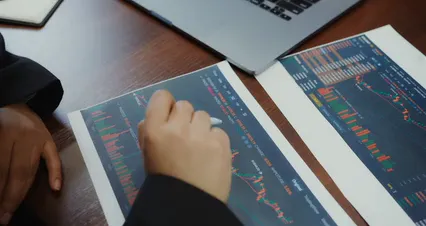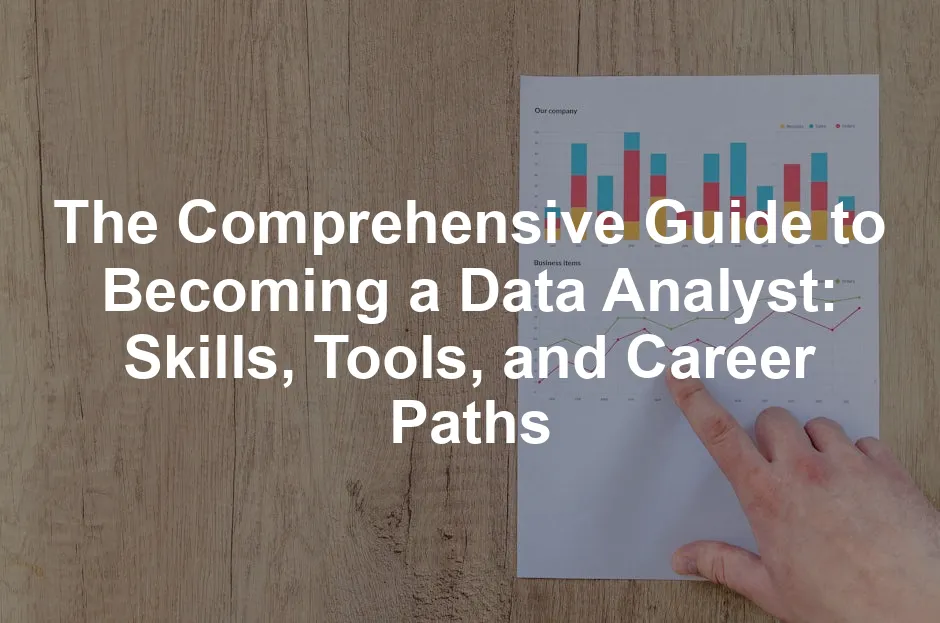Introduction
In today’s data-driven world, the role of a data analyst has never been more critical. Think of them as modern-day detectives—sifting through mountains of numbers to uncover hidden trends and insights that drive business decisions. If you’ve ever wondered how companies optimize their strategies or predict market trends, you can thank data analysts for that! They are the unsung heroes behind the curtain, transforming raw data into actionable recommendations. So, what exactly does a data analyst do? They collect, clean, and interpret data, ensuring that organizations make informed choices. This post will explore everything you need to know about becoming a data analyst. We’ll cover essential skills, tools, and potential career paths. You’ll soon see how this exciting field is more than just crunching numbers—it’s about storytelling with data! As we dive deeper into this guide, you’ll discover the various roles a data analyst can play. From finance to healthcare and e-commerce, analysts are in demand across industries. With businesses increasingly relying on data to guide their strategies, the opportunities for growth are vast. And if you want to get started on this journey, consider picking up a copy of SQL for Data Analytics: A Beginner’s Guide. It’s a great starting point to learn the ropes of data analysis! With the right skills and tools, you can become a key player in any organization. Whether you’re a recent graduate or looking for a career change, understanding the path to becoming a data analyst is crucial. So, let’s equip you with the knowledge you need to jump into this thriving field and make your mark!
Summary
Data analysts are the backbone of decision-making in organizations across various industries. As businesses increasingly rely on data to guide their strategies, the demand for skilled analysts continues to grow. In this comprehensive guide, we will cover:- What a Data Analyst Does: Understanding their role in collecting, cleaning, and interpreting data to provide actionable insights. Data analysts examine complex datasets to pinpoint trends and patterns, ultimately influencing strategic decisions.
- Key Skills Required: Discover the essential technical and soft skills that every aspiring data analyst should cultivate. Proficiency in SQL, data visualization, and statistical analysis are paramount, alongside strong communication and problem-solving abilities.
- Tools of the Trade: A rundown of popular software and programming languages used in the field, including SQL, Excel, Tableau, and Python. Familiarity with these tools will empower you to manipulate and visualize data effectively.
- Career Paths: Explore the various sectors where data analysts are in demand and the potential for career advancement. Analysts can work in finance, healthcare, marketing, and more, with opportunities to progress into specialized roles.
- Educational Requirements: Learn about the different educational paths and certifications available for aspiring analysts. Degrees in statistics, computer science, or business analytics can set you on the right track.
- Salary Insights: Get an overview of salary expectations and growth potential in this career. As you gain experience and specialize, your earning potential can increase significantly.

What Does a Data Analyst Do?
Overview of Responsibilities
A data analyst wears many hats, each more colorful than the last! First off, they collect and clean data from various sources. Imagine a chef gathering fresh ingredients for a gourmet meal. If the ingredients (data) are spoiled or unclean, the dish (insights) will taste terrible. So, data analysts meticulously sift through data, ensuring it’s accurate and ready for analysis. Once the data is clean, analysts dive into the numbers to identify trends and patterns. This is like spotting constellations in a starry sky. They use statistical tools and software to make sense of the chaos, transforming raw numbers into meaningful insights. Want to know how many customers preferred chocolate over vanilla? A data analyst has you covered! And speaking of tools, if you want to dive deeper into Python, I recommend grabbing Python for Data Analysis by Wes McKinney. It’s a fantastic resource for learning how to analyze data with Python! But what’s the point of all this analysis if no one understands it? That’s where visualizations and reports come into play. Data analysts create charts, graphs, and dashboards to communicate their findings effectively. Think of them as storytellers, using visuals to narrate the tale of the data. These reports help stakeholders grasp complex information quickly and make informed decisions. Collaboration is another vital piece of the puzzle. Data analysts work closely with other departments to align data insights with business strategies. They act as liaisons between the technical and non-technical teams, ensuring everyone is on the same page. This teamwork enables organizations to leverage data effectively, driving growth and innovation. In summary, a data analyst is a data detective, trend spotter, visual storyteller, and collaborative partner, all rolled into one. Their role is crucial in guiding businesses toward data-driven decisions, making them indispensable in today’s data-centric environment. If you want to learn more about the business side of data, consider reading Data Science for Business: What You Need to Know About Data Mining and Data-Analytic Thinking. It’s a great guide for understanding how data can drive business decisions!
Types of Data Analysis
When it comes to data analysis, not all methods are created equal. Let’s break down the four main types of data analysis that data analysts use to tackle various business challenges. Descriptive Analysis is the first stop on this analytical journey. It involves summarizing historical data to understand what has happened in the past. Think of it as the “what” of data analysis. By examining sales figures, customer demographics, or website traffic, analysts can identify trends over time. This helps businesses understand their performance and customer behavior. If you’re curious about data mining, a great read is Data Mining: Concepts and Techniques. It’s a comprehensive look at the subject! Next up is Diagnostic Analysis. This type digs deeper, investigating past performance to determine why certain outcomes occurred. It’s like being a detective trying to solve a mystery. If sales dipped in a specific quarter, diagnostic analysis looks for reasons—was it due to seasonal changes, a marketing campaign gone wrong, or perhaps a new competitor? This analysis answers the “why” behind the numbers. Then we have Predictive Analysis, which is all about forecasting future outcomes. Analysts use statistical models and machine learning algorithms to predict trends based on historical data. Want to know how many pairs of shoes your store will sell next month? Predictive analysis can help with that! It’s the crystal ball of the data world, allowing businesses to prepare for what’s ahead. If you’re interested in machine learning, check out Machine Learning Yearning by Andrew Ng. It’s a must-read for understanding the principles of machine learning! Finally, there’s Prescriptive Analysis. This method recommends actions based on data analysis. While predictive analysis tells you what might happen, prescriptive analysis suggests what you should do about it. It’s like having a personal advisor guiding you through decisions. Businesses can optimize operations, reduce costs, and improve customer satisfaction using this insightful approach. In conclusion, data analysts employ descriptive, diagnostic, predictive, and prescriptive analysis to transform data into actionable insights. Each type plays a unique role in helping businesses navigate the complex waters of decision-making, ensuring they stay ahead of the game.
Skills Required to Become a Data Analyst
To thrive as a data analyst, you need a unique blend of technical prowess and soft skills. Let’s break down these essential skills into two main categories: technical skills and soft skills.Technical Skills
Proficiency in SQL is a must-have for any data analyst. SQL (Structured Query Language) allows analysts to manage and manipulate databases effectively. It’s the backbone of data retrieval, enabling you to extract meaningful insights from vast datasets. Without SQL, you’ll find yourself lost in a sea of data, like trying to find a needle in a haystack without a magnet! And if you’re looking for a deep dive into SQL, SQL Practice Problems is a fantastic resource to sharpen your skills! Next up are data visualization tools like Tableau and Power BI. These platforms help you transform complex data into visually appealing charts and graphs. Imagine trying to explain a complex trend using just numbers—yawn, right? Visualizations make your findings engaging and digestible, turning your audience into fans rather than critics! For a comprehensive introduction, consider Tableau For Dummies. It’s perfect for getting started with data visualization!
Soft Skills
While technical skills are vital, soft skills are equally important for a data analyst. Strong analytical and problem-solving abilities are at the core of the role. You must think critically and identify trends and anomalies within datasets. Picture yourself as a detective piecing together clues to solve a mystery—every data point matters! Effective communication skills are essential for conveying complex data insights. You could generate the most groundbreaking data analysis, but if you can’t communicate it clearly, it’s like shouting into a void. Your ability to present findings to stakeholders is key, ensuring they understand the implications and act on your recommendations. Attention to detail is another crucial attribute. Data accuracy is non-negotiable; one tiny error can lead to significant misinterpretations. A successful data analyst is like a hawk, spotting discrepancies and ensuring that the data is pristine before drawing conclusions. Lastly, team collaboration skills are vital as data analysts often work with cross-functional teams. You’ll need to communicate effectively with colleagues from various departments, ensuring your insights align with organizational goals. A collaborative spirit fosters innovation and drives effective decision-making, making you an invaluable asset to any team.

Tools and Technologies
Essential Tools for Data Analysts
In the vast ocean of data, a data analyst needs reliable tools to navigate. Here are the essential tools that every analyst must have in their toolkit:- SQL: Structured Query Language is the bread and butter of data analysts. It allows them to query and manage databases efficiently. Whether it’s extracting specific data or aggregating information, SQL is the go-to language for accessing structured data. Analysts can perform complex queries to fetch valuable insights, making it an indispensable tool. statistics update sql server
- Excel: Ah, Excel—every analyst’s best friend! This classic tool is perfect for data manipulation and basic analysis. With its vast array of functions and features, Excel can handle everything from simple calculations to complex data modeling. Analysts love its pivot tables and charting capabilities that help in visualizing the data effortlessly. Sometimes, the simplest tools deliver the most powerful results! descriptive statistics excel
- Tableau/Power BI: Data visualization is crucial in conveying insights, and tools like Tableau and Power BI are industry favorites. They transform raw data into visually appealing dashboards and reports. These tools enable analysts to tell a story with data, making it easier for stakeholders to grasp complex information quickly. Interactive visualizations also foster engagement, turning data into a conversation starter!
- Python/R: For those looking to dig deeper into statistical analysis and modeling, Python and R are essential. Both programming languages offer libraries and frameworks tailored for data analysis. Python, with libraries like Pandas and NumPy, provides flexibility and power for data manipulation. On the other hand, R excels in statistical analysis, making it a favorite among statisticians. With these languages, analysts can perform advanced analyses, data wrangling, and modeling with ease. ap statistics formula sheet

Emerging Tools and Technologies
The data landscape is always evolving, and so are the tools that analysts use. Here are some emerging technologies making waves in the industry:- Big Data Technologies: As data continues to grow exponentially, tools like Hadoop and Spark are becoming increasingly vital. Hadoop allows for distributed storage and processing of large datasets, while Spark offers fast and efficient data processing capabilities. These technologies enable analysts to work with big data, uncovering insights from vast amounts of information that traditional tools simply cannot handle. If you’re interested in Hadoop, check out Hadoop: The Definitive Guide. It’s essential for understanding big data processing!
- Machine Learning Libraries: In the world of data analysis, machine learning is the cherry on top! Libraries like TensorFlow and Scikit-learn empower analysts to integrate predictive modeling into their workflows. These tools allow for the development of algorithms that can learn from data, enabling analysts to forecast trends and make data-driven predictions. The ability to harness machine learning opens up a new realm of possibilities for data analysis, making it more insightful and impactful. If you’re keen to learn about TensorFlow, consider TensorFlow for Dummies. It’s a great entry point into machine learning!
- Data Cleaning Tools: Data isn’t always clean and polished; that’s where tools like Alteryx and OpenRefine come into play. Alteryx simplifies the process of data preparation, allowing analysts to blend data from various sources and clean it efficiently. OpenRefine helps in cleaning and transforming messy data into a format suitable for analysis. These tools save time and ensure that analysts work with high-quality, reliable data, leading to better insights and decisions.


How to Become a Data Analyst
Educational Pathways
Becoming a data analyst starts with education. Relevant degrees include Mathematics, Statistics, Computer Science, and Business Analytics. These fields provide a strong foundation in the analytical skills you’ll need. Companies often seek candidates with these backgrounds because they demonstrate your ability to handle complex data sets. But wait! Not everyone has the time or resources for a four-year degree. Enter online courses and boot camps! These options can be fantastic alternatives for learning essential skills quickly. Many platforms offer courses designed specifically for aspiring data analysts. You can learn SQL, data visualization, and statistical analysis without the hefty student loan bill! If you’re interested in a structured learning path, consider Excel 2021 for Dummies. It’s a great resource for mastering Excel quickly! Self-study is also crucial. The world of data is constantly evolving. This means that even after completing formal education, you must commit to continuous learning. Follow industry trends, read relevant blogs, and participate in webinars. The more you know, the more valuable you become! In summary, whether through traditional degrees or alternative learning paths, a strong educational foundation is key. Equip yourself with knowledge, and you’ll be ready to tackle the exciting challenges of data analysis.
Gaining Experience
Education is just the beginning. To become a successful data analyst, gaining practical experience is essential. Start by looking for internships or entry-level positions. These roles provide you with hands-on experience, allowing you to apply what you’ve learned in real-world situations. Plus, employers love candidates who have shown initiative! statistics internships summer 2024 Building a solid portfolio is also important. Work on personal or volunteer projects that showcase your skills. For example, analyze publicly available datasets and share your findings. This not only enhances your abilities but also demonstrates your expertise to potential employers. A well-crafted portfolio can set you apart from the competition! If you’re interested in a career change, consider reading The Data Science Career Handbook. It’s a valuable guide for those looking to transition into data science! Networking is another invaluable strategy. Attend industry events and engage with professionals in the field. Platforms like LinkedIn can help you connect with experienced data analysts. These connections may lead to job opportunities, mentorship, or even collaborative projects. Remember, it’s not just what you know, but who you know! In conclusion, gaining experience through internships, projects, and networking will position you for success in the data analysis field. Get out there, make connections, and showcase your skills! If you’re interested in data-driven marketing, consider picking up Data-Driven Marketing: The 15 Metrics Everyone in Marketing Should Know. It’s a fantastic resource for understanding how to leverage data in marketing strategies.
All images from Pexels




